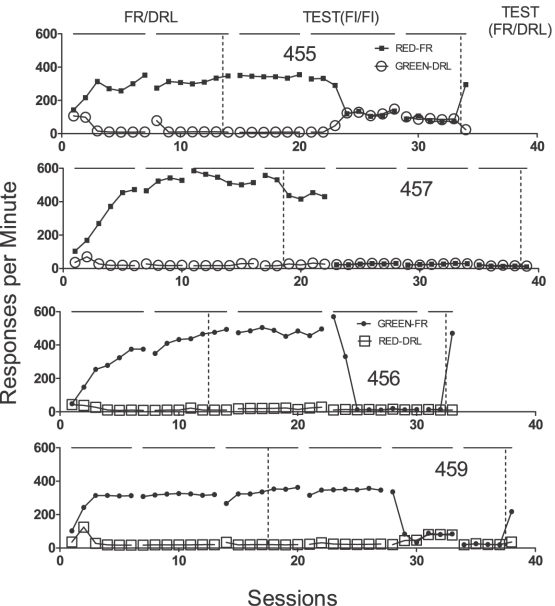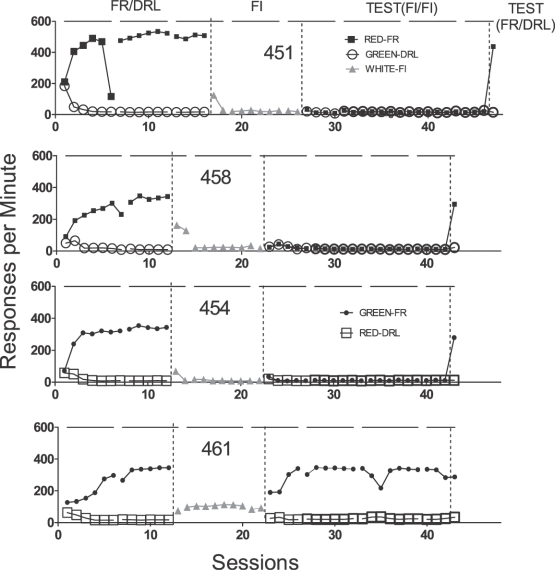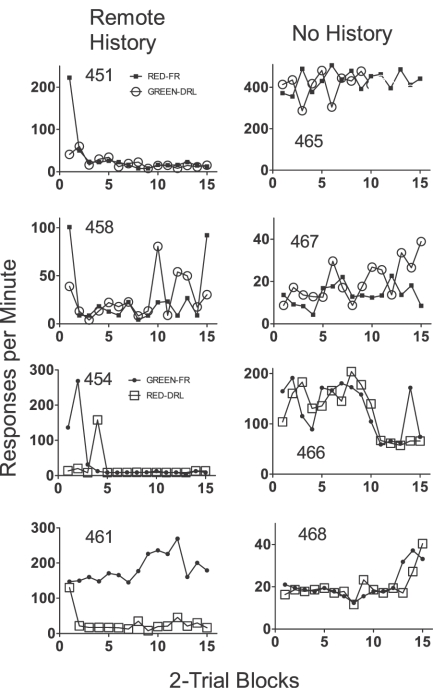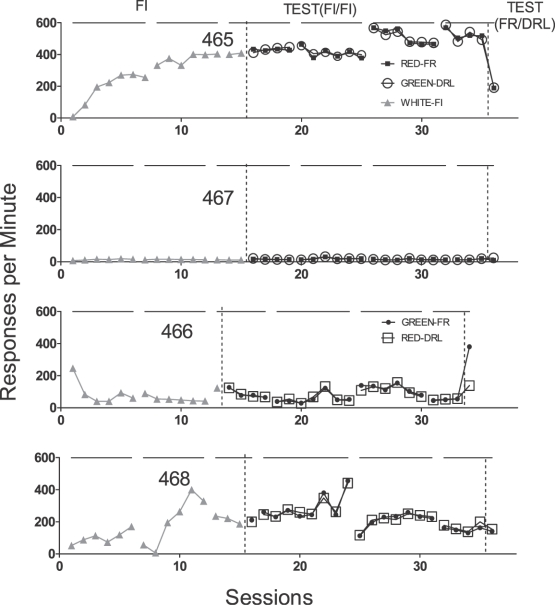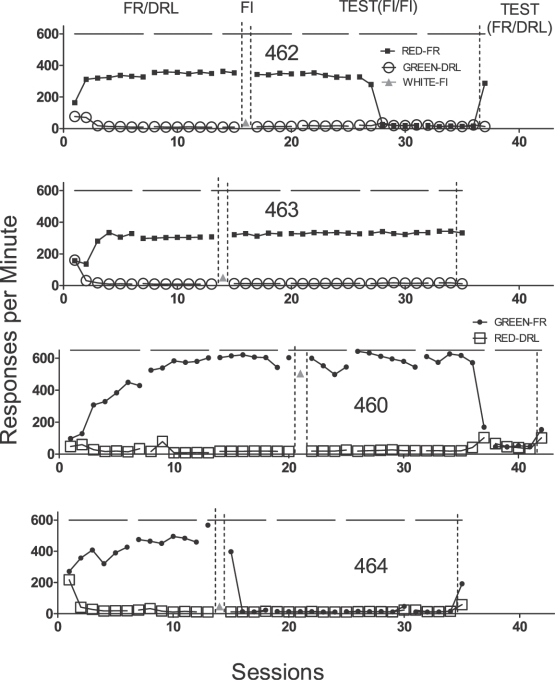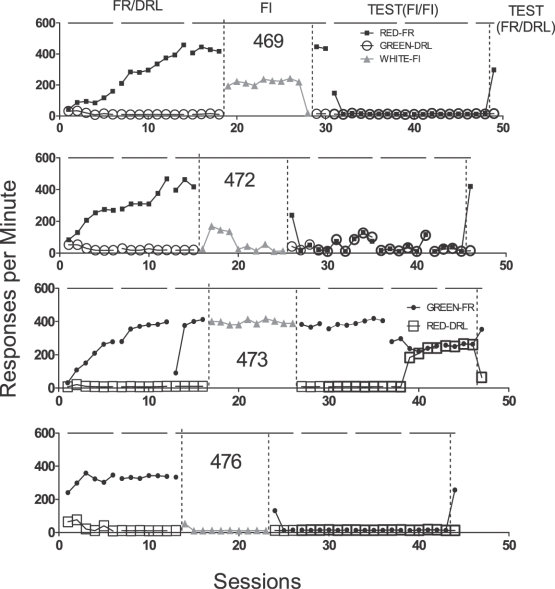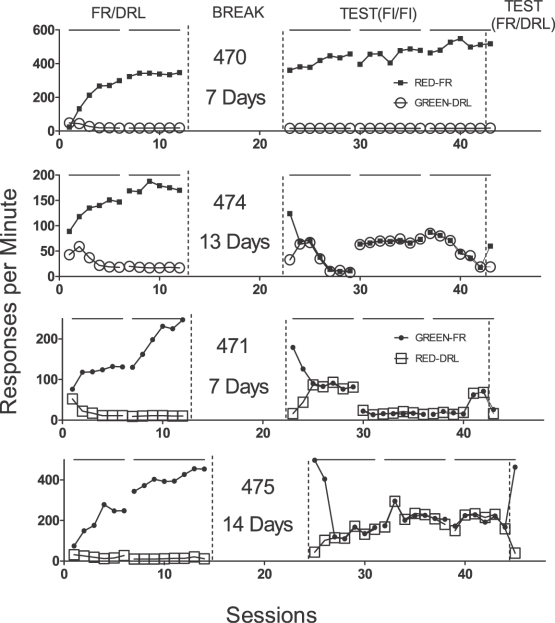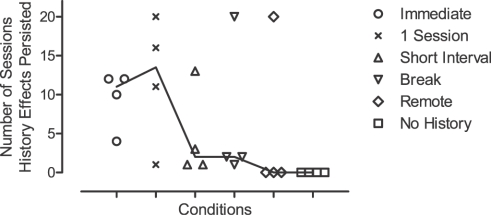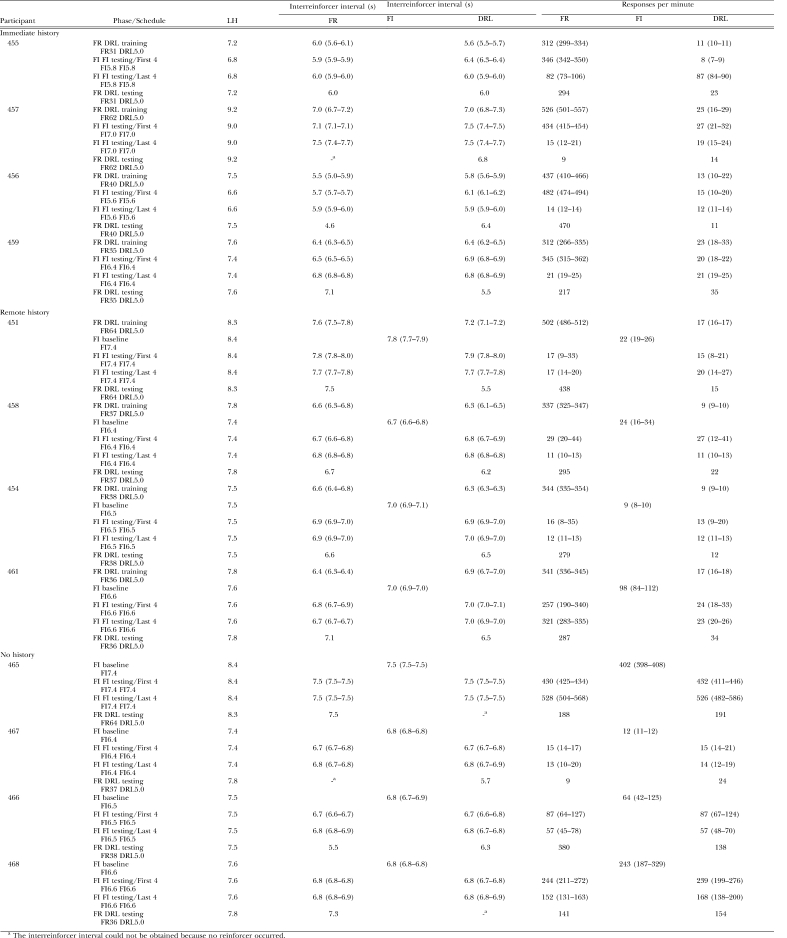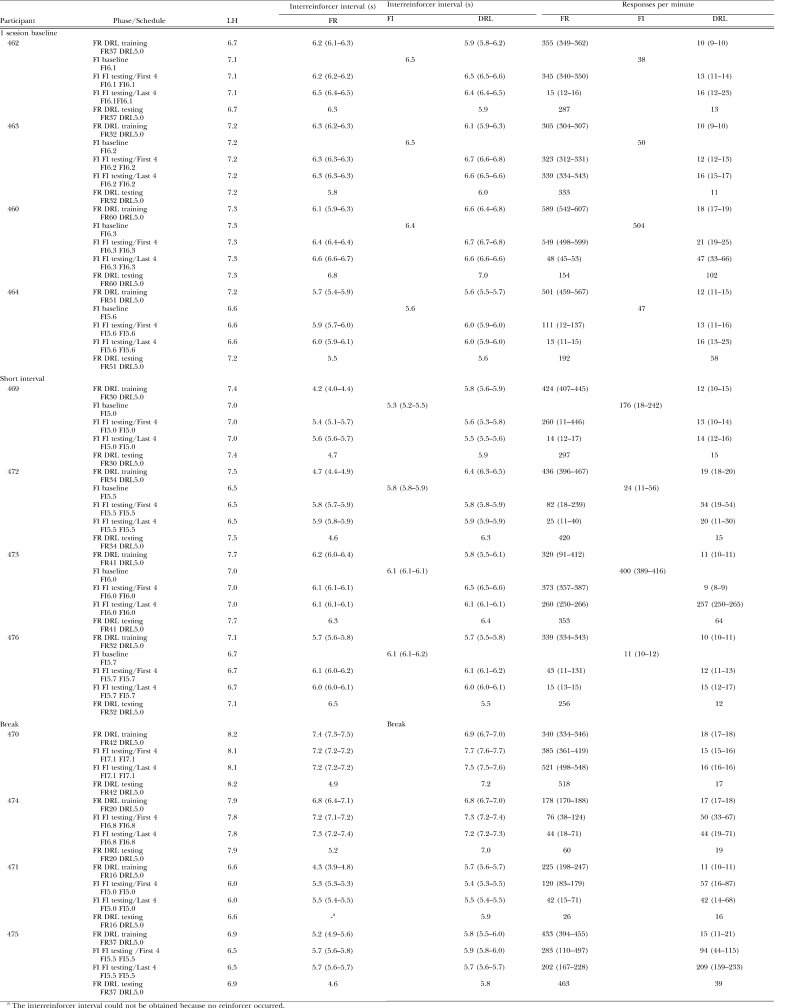Abstract
Undergraduates were exposed to a series of reinforcement schedules: first, to a fixed-ratio (FR) schedule in the presence of one stimulus and to a differential-reinforcement-of-low-rate (DRL) schedule in the presence of another (multiple FR DRL training), then to a fixed-interval (FI) schedule in the presence of a third stimulus (FI baseline), next to the FI schedule under the stimuli previously correlated with the FR and DRL schedules (multiple FI FI testing), and, finally, to a single session of the multiple FR DRL schedule again (multiple FR DRL testing). Response rates during the multiple FI FI schedule were higher under the former FR stimulus than under the former DRL stimulus. This effect of remote histories was prolonged when either the number of FI-baseline sessions was small or zero, or the time interval between the multiple FR DRL training and the multiple FI FI testing was short. Response rates under these two stimuli converged with continued exposure to the multiple FI FI schedule in most cases, but quickly differentiated when the schedule returned to the multiple FR DRL.
Keywords: behavioral history, remote control, stimulus control, within-individual comparison, fixed-interval schedules, screen touch, humans
An organism's current responses are affected by schedules immediately preceding the current ones (e.g., Lattal & Neef, 1996; St. Peter Pipkin & Vollmer, 2009; Wanchisen, 1990). For example, Weiner (1964) found that humans with histories of responding under fixed-ratio (FR) schedules responded at high rates under subsequent fixed-interval (FI) schedules, whereas those with histories of responding under differential-reinforcement-of-low-rate (DRL) schedules responded at low rates under the same subsequent FI schedules.
Responding also may be affected by schedules that were in effect in the remote past. Weiner (1969) exposed humans to DRL, FR, and FI schedules in that order. Response rates under the FI schedule were low and not similar to those obtained under the FR schedule that had been in effect immediately before the current FI schedule. Rather, the rates more closely resembled those occurring under a DRL schedule that was in effect long before the FI (see also Barrett, 1977).
Contrasted with the effects of immediate histories, which have been found ubiquitously (e.g., Nader & Thompson, 1987; Urbain, Poling, Millam, & Thompson, 1978; Wanchisen, Tatham, & Mooney, 1989), relatively little is known about the effects of more temporally remote experiences. The present experiments examined these remote history effects, focusing on the role of events that occur between history-building and subsequent history-testing conditions on contemporary behavior.
History effects have been assessed both between and within individuals. In experiments employing a between-individual design, different groups of individuals are provided different histories, and the effects of such histories on current performance are compared across the individuals (Weiner, 1964). Using this design, remote history effects have been demonstrated under a few conditions (Okouchi, 2007, 2010; Weiner, 1969, 1982; but see also Cole, 2001; LeFrancois & Metzger, 1993). In experiments employing a within-individual design, individuals are exposed to different histories, in the form of schedules, in the presence of different stimuli. Subsequently, testing schedules are implemented in the presence of those same stimuli. Thus, history effects are examined by comparing performances under the current testing schedules across the stimuli. Using a within-individual design to assess history effects permits both an assessment of the effects without relying on between-individual comparisons of response rates, which vary across individuals (Freeman & Lattal, 1992), and the possibility of isolating small but consistent differences in responding as a function of different histories (Okouchi & Lattal, 2006).
Using a within-individual design, Ono and Iwabuchi (1997) demonstrated remote history effects with pigeons. Ono and Iwabuchi first exposed pigeons to differential-reinforcement-of-high-rate (DRH) and DRL schedules that were correlated with green and red keys, respectively. Then a variable-interval (VI) schedule was in effect in the presence of a white key for 15 sessions. Finally, the VI schedule continued to operate but the key color changed quasirandomly between green, red, and white. Response rates were higher on the green key, which had been correlated with the DRH schedule, than on the red key, which had been correlated with the DRL, indicating that the current behavior was affected by stimuli previously correlated with schedules in effect in the remote past.
Remote behavioral history effects have been studied with humans under only limited conditions. Both Okouchi (2007, 2010) and Weiner (1969, 1982) found differential responding on a common schedule after different groups of human participants first were exposed to different schedules and then an intervening condition. Within-individual analyses of remote history effects in humans appear to be limited to demonstrations of resurgence (e.g., Bruzek, Thompson, & Peters, 2009; Lieving, Hagopian, Long, & O'Conner, 2004), which report such effects during extinction and in the absence of differential schedule experience in the history-building condition. The present Experiment 1 was designed to examine whether differential remote history effects like those obtained by Ono and Iwabuchi (1997) can be replicated with humans under FI schedules when the remote history consists of a differential history of exposure to schedules controlling high and low response rates. Subsequent manipulations in Experiment 2 isolated further the role of events in the intervening conditions as controlling variables of remote behavioral history effects.
EXPERIMENT 1
Method
Participants
Three male and 11 female undergraduates recruited from an educational psychology class at Osaka Kyoiku University participated. They were 19 to 24 years old, and none had experience with operant conditioning experiments.
Apparatus
The experimental room was 1.70 m wide, 2.20 m long, and 2.17 m high. A Nihon Electric Company PC-9821AP microcomputer, located in an adjacent room, was used to control the experiment. The participant sat at a desk facing a color display monitor (250 mm wide by 180 mm high) equipped with a Micro Touch Systems touch screen. A response was defined as a touch to a colored circle (55 mm diameter) presented in the center of the black screen. All inter-event times were recorded in real time with a 50-ms resolution. A second, white, circle (30 mm in diameter) was presented at the bottom left of the monitor screen, and each touch to that circle (defined as a consummatory response) produced 100 points. Each touch to the circles was accompanied by a brief sound through a speaker located beneath the desk. A point counter was located at the top right of the screen.
Procedure
Participants signed an informed consent agreement that specified the frequency and duration of their participation and the average earnings for such participation. They agreed to remain in the experiment for a maximum of eight 90-min periods. At the beginning and end of the experiment, each participant was asked not to speak to anyone other than the experimenter about the study in an attempt to prevent discussion about the contingencies among participants (cf. Horne & Lowe, 1993). At the end of the experiment, each participant was asked whether he or she had any information to offer about the study. None reported that they did.
A 90-min experimental period was conducted once per day, two times per week. During this period, a maximum of eight variable-duration sessions occurred (range = 6–28 min). Sessions were separated by 2- to 3-min breaks. After every experimental period, participants were paid for their performance (1 yen per 100 points, approximately .009 U.S. dollars). On completion of the entire experiment, participants were paid for their participation (200 yen per 90 min) and were debriefed. The overall earnings for each participant who completed the entire experiment ranged from 2,980 to 4,430 yen (approximately 26.82 to 39.87 U.S. dollars).
On the first day of the experiment, each participant was asked to leave wristwatches, cellular phones, and books outside the experimental room. Once in the room, the participant was asked to read silently the following instructions (translated here from Japanese into English):
Your task is to earn points. A hundred points are worth one yen. Payment for the points will be made at the end of each visit. In addition, you will be paid 200 yen for every day you spend in the experiment. Payment for participation will be made at the end of the last visit.
A circle will be shown in the center of the screen of the display monitor. If you touch the circle, the circle may disappear, then a small circle will appear in the bottom left of the monitor screen. By touching the small circle, you can earn points. Accumulated points will be shown in the top right of the screen.
The words “READY” and “GO” will appear in sequence on the screen. When the word “GO” disappears, the task will start. The task will continue until the words “GAME OVER” appear on the screen.
During the task, the word “WAIT” may appear on the screen. When this word appears, please wait until the center circle reappears.
The printed instructions remained on the desk throughout the experiment. Questions regarding the experimental procedure were answered by telling the participant to reread the appropriate sections of the instructions. Then the words “READY” and “GO” were presented in sequence at the top left of the screen. After the word “GO” disappeared, a circle, which served as the operandum, was presented in the center of the screen.
When the schedule requirement was met, the center circle was darkened and the circle for the “consummatory response” was presented at the bottom left of the screen. A touch during a 3-s consummatory response period darkened the circle and accumulated 100 points on the top right counter, followed by a timeout. The timeout was used to bring the total time for the latency for the comsummatory response plus the timeout to 3 s. If the participant did not touch the circle during this period, neither point accumulation nor timeout followed. Participants failed to touch the circle during this period a total of 18 times during the experiment, out of 27,380 opportunities for the consummatory response. After the session terminated, the words “GAME OVER” appeared at the top left of the screen.
Participants were assigned to one of three conditions: remote history, immediate history, and no history. Remote-history participants were exposed to the following sequence of phases: a multiple FR DRL training phase, an FI baseline phase, a multiple FI FI testing phase, and a multiple FR DRL testing phase, in that order. The other participants also were exposed to these phases in the same order, the only difference being that the FI baseline phase and the multiple FR DRL training phase were omitted for the immediate-history participants and the no-history participants, respectively. The phase was changed within a 90-min experimental period (Sidman, 1960, p.310). The details of each phase were as follows.
Multiple FR DRL training phase
A multiple FR DRL schedule was in effect. The center circle on the monitor screen was green in the FR schedule component and red in the DRL schedule component for Participants 451, 452, 453, 455, 457, and 458. For Participants 454, 456, 459, and 461, the colors were reversed: the FR schedule was assigned to red and the DRL schedule to green.
During the first four sessions of this phase, each component was presented once per session and lasted until 30 reinforcers occurred. The FR and DRL schedule values then were increased progressively over these sessions. That is, the values for the FR and DRL schedules in the first, second, third, and fourth sessions of this phase were 5 responses and 1 s, 10 responses and 2 s, 15 responses and 3 s, and 25 responses and 5 s, respectively. When the DRL schedule was in effect, any interresponse time (or postreinforcement pause followed by a response) that was longer than the DRL value produced a reinforcer. The DRL schedule component always preceded the FR. There was no interval between the components for Participants 451, 452, and 453, but a 1-min interval, during which the circle disappeared and the word “WAIT” was presented at the top left of the screen, was inserted between the components for the other participants. This procedural change was precipitated by weak performances by Participants 452 and 453. They were dismissed after exposure to nine and eight sessions of the multiple FR DRL schedule, respectively, with no sign of response-rate differentiation between the FR and DRL schedules.
The procedure beginning with Session 5 of this phase is unique in two ways. First, the values of FR and FI schedules were determined to equate interreinforcer intervals (IRIs) across schedule components and phases. This was done to hold one of the potential controlling variables of history effects, IRI, constant (e.g., Freeman & Lattal, 1992; LeFrancois & Metzger, 1993). Second, components of the multiple schedule were sequenced quasirandomly, and each included a limited-hold (LH) contingency. This discrete-trial-like multiple schedule procedure was used to strengthen stimulus control by color. The stimulus that is most reliably correlated with reinforcement can exert the greatest control over responding. When components change at random, have similar IRIs and both have an LH, there is little to distinguish them other than the color stimuli. Thus, it was expected that the circle color would exert discriminative control over the responding. Changing stimuli within a session also permits detecting short-lived effects even if they disappear during the first test session, as they did for Okouchi's (1999) Subject 4. These features were implemented as explained next.
Beginning with Session 5 of this phase, a new component was selected randomly after each reinforcer, with the restriction that each occurred twice with every block of four reinforcers. The 1-min intercomponent interval was eliminated. The DRL value was set at 5 s, and the FR at 25. During the next four sessions, the value of the FR component was set by multiplying the mean number of responses per second in the FR component in the immediately preceding session by the mean IRI in the DRL component of the same session (cf. Freeman & Lattal, 1992). For the remainder of the sessions in the multiple FR DRL training phase, the FR values were fixed at the values given in Appendix A.
An LH was imposed on each schedule from Session 6 in the multiple FR DRL training phase. Unlike the traditional use of an LH (e.g., Catania, 1998, p.396), the present experiment timed the LH from the start of each trial (Okouchi, 2002). If the schedule requirement was not met within a given LH, a 3-s timeout, during which the circle disappeared from the screen and reinforcement was not available. The LH value in Session 6 was 4 s plus the mean IRI of the FR and DRL components during the immediately preceding session. This value was decreased gradually across three sessions (but across 5 and 11 sessions for Participants 451 and 457, respectively) to 1 s (but 2 s for Participant 457) plus the mean IRI. The final LH values for participants in the immediate-history and remote-history conditions are shown in Appendix A. Components could end without a reinforcer accruing during the trial when responding did not meet the schedule requirements in effect during that component. Each session lasted until 60 reinforcers occurred.
The multiple FR DRL training phase lasted for a minimum of 12 sessions and until there were no more than three non-reinforced trials in either component per session over two consecutive sessions. This criterion is hereafter described as the mastery criterion.
FI baseline phase
Following the multiple FR DRL training phase, an FI schedule, defining the FI baseline phase, was in effect for 10 sessions for the remote-history participants. The center circle on the screen was white. For each participant, the FI value was determined by averaging the mean IRIs of the two components of the final four sessions of the multiple FR DRL training phase (Appendix A). The LH value for each individual was 1 s plus the FI value. Each session ended when 60 reinforcers had been obtained. Other details of the procedure were the same as in the final sessions of the multiple FR DRL training phase.
The procedure in the FI baseline for the no-history participants was identical to that for the remote-history participants, with the following exceptions. The FI values for Participants 465, 467, 466, and 468 in the no-history condition were yoked to those for Participants 451, 458, 454, and 461 in the remote-history condition, respectively. No LH contingency was in effect in the first session. Across the next four to six sessions, the LH value was decreased gradually from 4 s plus the FI value to 1 s plus that value. With the final LH value in effect, each participant was exposed to 10 FI-baseline sessions. As a result of this LH contingency, Participants 465, 467, 466 and 468 experienced 3, 40, 7, and 43 nonreinforced trials during these 10 sessions, respectively.
Multiple FI FI testing phase
A multiple FI FI schedule, defining the multiple FI FI testing phase, was in effect for 20 sessions. The procedure in the FI testing phase was identical to that in the FI baseline phase with the following exceptions. The color of the center circle, red and green, was selected randomly after every trial (i.e., every FI) with the restriction that each stimulus occurred twice within every block of four trials. For each of the immediate-history participants, the FI value was determined by averaging the mean IRIs of the two components of the final four sessions of the multiple FR DRL training phase (Appendix A). The LH values were 1 s plus the FI values for Participants 455, 456, and 459, whereas it was 2 s plus the FI value for Participant 457.
Multiple FR DRL testing phase
A single session was conducted during which a multiple FR DRL schedule was in effect. The procedure in the multiple FR DRL testing phase was identical to that in the final sessions of the multiple FR DRL training phase with the following exceptions. The session lasted until 60 trials (but not necessarily 60 reinforcers) occurred. The FR, DRL, and LH values for the no-history participants were yoked to those of their partners in the remote-history conditions.
Results
Appendix A shows the mean IRIs (with ranges in parentheses) in the FR and DRL components for the last four sessions in the multiple FR DRL training phase for the immediate- and remote-history participants. For Participants 455, 457, 456, 459, and 458, the ranges of IRIs for the FR and DRL components overlapped. For the remainder of the participants, the ranges did not overlap, but the differences in the mean IRIs between the components were within 0.6 s of one another.
Figure 1 shows the response rates in each session for each participant in the immediate-history condition (see also Appendix A). During all sessions of the multiple FR DRL training phase, response rates were higher in the FR component than in the DRL component. During at least the first four sessions of the multiple FI FI schedule, response rates were higher in the presence of the stimulus previously correlated with the FR schedule (the former FR stimulus) than in the presence of the stimulus previously correlated with the DRL schedule (the former DRL stimulus). This difference was found during the first 10, 4, 12, and 12 sessions for Participants 455, 457, 456, and 459, respectively. Thereafter, the rates under the different stimuli became nondifferentiated. When the multiple FR DRL schedule was in effect again in the multiple FR DRL testing phase, the response-rate differentiation was reinstated for all but Participant 457.
Fig 1.
Response rates in each session for each participant in the immediate-history condition of Experiment 1. FR/DRL and Test (FR/DRL), respectively, identify the multiple FR DRL training and the multiple FR DRL testing phases in which a multiple FR DRL schedule was in effect. Test (FI/FI) identifies the multiple FI FI testing phase in which a multiple FI FI schedule was in effect. Horizontal bars indicate the durations of successive experimental periods.
Figure 2 shows the response rates in each session for each participant in the remote-history condition (see also Appendix A). As in the immediate-history condition, response rates were higher in the FR component than in the DRL component during all sessions of the multiple FR DRL training phase. The final response rates in the FI baseline phase were higher than the prior DRL rates and lower than the prior FR rates for Participant 461, whereas they were approximately equal to the prior DRL rates for Participants 451, 458, and 454. When the stimuli previously correlated with the FR and DRL schedules were correlated with the FI schedules, response rates in the presence of the former FR stimulus were higher than those in the presence of the former DRL stimulus during all sessions for Participant 461. For the remainder of the participants, the response rates in the presence of the two stimuli were not systematically different from one another.
Fig 2.
Response rates in each session for each participant in the remote-history condition of Experiment 1. FI identifies the FI baseline phase in which an FI schedule was in effect in the presence of a white circle (operandum) on the monitor screen. Other details are as in Figure 1.
Data from within the first session, however, reveal a remote history effect. The left graphs of Figure 3 show response rates in each two-trial block across the first session of the multiple FI FI testing phase for the remote-history participants. Response rates under the former FR stimulus were higher than those under the former DRL stimulus during the first block for Participants 451 and 458 and during the first three blocks for Participant 454, indicating very short-lived but consistent differences. Returning to Figure 2, the last panel of each graph shows that when the multiple FR DRL schedule was reintroduced in the multiple FR DRL testing phase, response-rate differentiation was reestablished for Participants 451, 458, and 454, and maintained for Participant 461.
Fig 3.
Response rates in each two-trial block during the first session of the multiple FI FI testing phase for each participant in the remote-history condition (left graphs) and in the no-history condition (right graphs) of Experiment 1. The y-axes are scaled individually for each participant.
Figure 4 shows the response rates in each session for each participant in the no-history condition (see also Appendix A). Consistent with previous findings from humans having no experimental history (cf. Lowe, 1979), response rates under the FI schedule were variable across participants, higher for Participants 465 and 468 and lower for Participants 467 and 466. During all sessions of the multiple FI FI testing phase, the rates in the two components for all participants were indistinguishable. Figure 3 (right graphs) shows that the within-session data from the first session also were consistent with these overall-session data (Figure 4). When the multiple FR DRL schedule was in effect in the multiple FR DRL testing phase, the response-rate differentiation was established only for Participant 466.
Fig 4.
Response rates in each session for each participant in the no-history condition of Experiment 1. Details are as in Figure 2.
Discussion
In general, history effects have been assessed by whether they occurred and, if so, how long they persisted (Okouchi, 2007). In these respects, the results of the immediate-history participants are consistent with those of previous experiments using a within-individual design (e.g., Freeman & Lattal, 1992; Okouchi, 1999). First, response rates established with two different schedules in the presence of two different stimuli carried over to a third schedule, demonstrating immediate history effects within individual participants. Second, these immediate history effects disappeared with continued exposure to the current schedule. This concurrence indicates that the previous findings were replicated and the present procedure was sound for examining history effects.
Response rates under the stimulus previously correlated with the FR schedule were higher than those under the stimulus previously correlated with the DRL schedule during all 20 sessions of the multiple FI FI testing phase for Participant 461. This was the case even though the current contingencies of the multiple FI FI schedule were separated from the history of the multiple FR DRL schedule by the FI baseline. For the other remote-history participants, such a response-rate differentiation predicted by the remote history was observed during only the first one to three 2-trial blocks of the first session in the multiple FI FI testing phase (see Figure 3). By contrast, there was no systematic difference in response rate between the components of the multiple FI FI testing across the no-history participants. Thus, very short-lived, but consistent, effects of the remote history were obtained for Participants 451, 458, and 454.
The results of the multiple FR DRL testing phase also provide evidence of remote history effects. For 7 of 8 participants, response rates in the FR component were higher than those in the DRL component, whereas such a response-rate differentiation was observed only for 1 of 4 participants who had no previous exposure to the same contingencies. The only procedural difference between the history and no-history conditions was whether the participants first were exposed to the multiple FR DRL schedule. Thus, differences in discrimination during the multiple FR DRL testing phase can be attributed to the histories built during the multiple FR DRL training phase for the history-condition participants.
Ono and Iwabuchi (1997) found that a history of responding on DRH and DRL schedules affected subsequent responding of pigeons under a VI schedule even though the latter was separated from the earlier DRH/DRL condition by the VI baseline. The present results replicated this finding with different schedules (FR and DRL histories and FI baseline and test) and a different species (humans). The present results, however, are limited in that the effects obtained from a majority of the participants were very transient. For each of 3 pigeons of Ono and Iwabuchi, response rates in the presence of a stimulus previously correlated with the DRH schedule were higher than those in the presence of a stimulus previously correlated with the DRL during all 10 of their testing sessions, whereas such a response-rate differentiation did not survive during even a single session for 3 of the 4 participants in the present experiment.
The procedural properties of the immediate-history condition, which produced relatively long-lasting immediate-history effects, may provide insight into the short-lived remote-history effects. The procedural differences between the remote- and immediate-history conditions were (a) whether the FI baseline was inserted between the training and testing or not, and (b) whether the time interval between the training and testing was long or short. Specifically, 10 FI baseline sessions were conducted before implementing the multiple FI FI testing phase in the remote-history condition, whereas no such baseline session occurred in the immediate-history condition. The multiple FI FI testing phase started on the day after 3, 9, 8, and 7 days, respectively, after the multiple FR DRL training phase was completed for Participants 451, 458, 454, and 461 in the remote-history condition. For the immediate-history participants, by contrast, the first sessions of the multiple FI FI testing phase always were conducted during the experimental period that included the last sessions of the multiple FR DRL training phase. The persistence of the history effects could be affected by either or both of these two variables.
In Experiment 2 these variables were manipulated to determine whether the remote history effects obtained in Experiment 1 could be replicated under three different conditions. In the first, “one-session baseline” condition, the number of sessions that the FI baseline was in effect was reduced from 10 (for the remote-history condition in Experiment 1) to one. This occurred within the same 90-min experimental period as the last sessions of the multiple FR DRL history training and the first sessions of the multiple FI FI testing. In the second, “short interval” condition, there were again 10 sessions of the FI baseline but they all occurred within a 180-min experimental period that included final sessions of the multiple FR DRL and initial sessions of the multiple FI FI. Thus, the multiple FI FI testing occurred much sooner after history building than in the remote-history condition, but with the same amount of the FI baseline. In the third, “break” condition, testing in multiple FI FI occurred some days after the multiple FR DRL training and without an intervening FI baseline. The procedures for this condition were similar to those for the immediate-history condition in Experiment 1 except that the multiple FI FI testing was delayed. Thus, the effects were examined when the number of FI-baseline sessions was small (1) or large (10), with history testing commencing within the same experimental period, and when it was zero but with history testing delayed by several days.
EXPERIMENT 2
Method
Participants and Apparatus
Six male and 6 female undergraduates, 19 to 22 years old, were assigned to one of three conditions: one-session baseline, short interval, or break. Details of participant screening, informed consent, participant payment, and apparatus were identical to those employed in Experiment 1, with the exceptions that participants in the short-interval condition were asked and agreed to participate in seven 90-min and one 180-min experimental periods, and that participants in the break condition were informed and agreed that the experimental period usually would be conducted twice a week, but sometimes would be scheduled at intervals of 1 or 2 weeks.
Procedure
Details of the procedure were as described in the remote-history condition of Experiment 1, with the following exceptions. For the one-session-baseline participants, the FI baseline phase consisted of only a single session, and the initial sessions of the multiple FI FI testing phase occurred within the same experimental period in which the multiple FR DRL training phase was completed. For the short-interval participants, the last four (Participants 469 and 473), three (Participant 472), or one (Participant 476) sessions of the multiple FR DRL training phase, all 10 sessions of the FI baseline phase, and the first two (Participant 469) or three (Participants 472, 473, and 476) sessions of the multiple FI FI testing phase occurred within a single 180-min experimental period. A 10-min break occurred after 90 min of the experimental period. For the break participants, the FI baseline phase was omitted. The multiple FI FI testing was conducted 7 (Participants 470 and 471), 13 (Participant 474), or 14 (Participant 475) days after the training criterion of the multiple FR DRL had been met. These time intervals between the multiple FR DRL training phase and the multiple FI FI testing phase were comparable to or longer than those experienced by the remote-history participants in Experiment 1.
Individual schedule parameters are shown in Appendix B. Because the performance did not meet the mastery criterion, as described in the Method section of Experiment 1, the multiple FR DRL training phase for Participant 464 in the one-session-baseline condition terminated when there were no more than three nonreinforced trials in either component in a single session (rather than two consecutive sessions), and the LH value for Participant 469 in the short-interval condition was increased to and set at 2 s plus the mean IRI of the FR and DRL components in the multiple FR DRL training phase.
Results
Appendix B shows the mean IRIs (with ranges in parentheses) in the FR and DRL components for the last four sessions of the multiple FR DRL training phase for each participant. The ranges of IRIs for the FR and DRL components overlapped for Participants 462, 463, 464, 473, 476, 474, and 475, whereas they did not for the remainder of the participants. The differences in the mean IRIs between the components for Participants 460, 469, 472, 470, and 471 were 0.5 s, 1.6 s, 1.7 s, 0.5 s, and 1.4 s, respectively.
Figure 5 shows the response rates in each session for each participant in the one-session-baseline condition (see also Appendix B). With continued exposure to the multiple FR DRL schedule, response rates increased in the FR component and decreased in the DRL component. The response rate in the FI baseline phase was approximately equal to the prior FR rates for Participant 460, whereas they were approximately equal to the prior DRL rates for the remainder of the participants. When the stimuli previously correlated with the FR and DRL schedules were correlated with the FI schedules, response rates under the former FR stimulus were higher than those under the former DRL stimulus during all sessions for Participant 463 and during the first 11, 16, and 1 sessions for Participants 462, 460, and 464, respectively. When the multiple FR DRL schedule was in effect again in the multiple FR DRL testing phase, the response-rate differentiation was reestablished for Participants 462, 460, 464, and maintained for Participant 463.
Fig 5.
Response rates in each session for each participant in the 1-FI-baseline condition of Experiment 2. Details are as in Figure 2.
Figure 6 shows the response rates in each session for each participant in the short-interval condition (see also Appendix B). In the multiple FR DRL training phase, response rates were higher in the FR component than in the DRL component. The final response rates in the FI baseline phase were approximately equal to the prior DRL rates for Participants 469, 472 and 476, and approximately equal to the prior FR rates for Participant 473. Response rates under the former FR stimulus during the multiple FI FI schedule were higher than those under the former DRL stimulus during the first 3, 1, 13, and 1 sessions for Participants 469, 472, 473, and 476, respectively. When the multiple FR DRL schedule was in effect again in the multiple FR DRL testing phase, the response-rate differentiation was reinstated for all participants.
Fig 6.
Response rates in each session for each participant in the short-interval condition of Experiment 2. Details are as in Figure 2.
Figure 7 shows response rates in each session for each participant in the break condition (see also Appendix B). As in the other conditions, response rates were higher in the FR component than in the DRL component in the multiple FR DRL training phase. Following introduction of the FI schedule in both components, response rates under the former FR stimulus were higher than those under the former DRL stimulus during all sessions for Participant 470 and during the first one, two, and two sessions for Participants 474, 471, and 475, respectively. When the multiple FR DRL schedule was in effect again in the multiple FR DRL testing phase, the response-rate differentiation was maintained for Participant 470 and reestablished for Participants 474 and 475 but not for Participant 471.
Fig 7.
Response rates in each session for each participant in the break condition of Experiment 2. The y-axes are scaled individually for each participant. Details are as in Figure 1.
Discussion
Following the introduction of the multiple FI FI schedule, response rates under a stimulus previously correlated with an FR schedule were higher than those under a stimulus previously correlated with a DRL schedule during at least one session for all 12 participants. This result strongly replicates the remote history effects obtained in Experiment 1.
Figure 8 shows the number of consecutive sessions during the multiple FI FI testing phase showing the response-rate differentiation predicted by the multiple FR DRL training for each participant in the two present experiments. As this summary figure illustrates, the numbers of consecutive sessions in which history effects occurred for the one-session-baseline participants were comparable to those for the immediate-history participants and generally were greater than those for the short-interval and break participants, whereas the numbers for the short-interval participants were approximately equal to those for the break participants and generally were greater than those for the remote-history participants. The differences in these numbers between the immediate-history and break conditions and between the short-interval and remote-history conditions suggest that the history effects were reduced by the time interval between when the history was built and when it was tested. Moreover, the difference between the break and remote-history conditions suggests that the effects were reduced as a function of the amount of exposure to an FI schedule between the history building and testing. The results of the one-session-baseline condition do not allow an assessment of how the time interval and amount of time of the intervening schedule independently contributed to the history effects. This is because both of these variables varied simultaneously. Nonetheless, the numbers of sessions that the history effects persisted in this condition are not inconsistent with the general finding obtained from other conditions that the history effects were influenced by both the amount of exposure to a schedule and the time interval between when the history was built and when it was tested.
Fig 8.
Number of consecutive sessions from session 1 of the multiple FI FI testing phase showing the response-rate differentiation predicted by the multiple FR DRL training for each participant in each condition of the two experiments. Because of no history of multiple FR DRL training, the numbers for each of the no-history participants indicates the sessions showing the differentiation predicted by the training for the yoked participant. Symbols show data from individual participants and solid lines connect group medians.
Despite the effort to equate IRIs, the ranges of IRIs did not overlap for the FR and DRL components for 3 and 5 participants in Experiments 1 and 2, respectively. This result may raise a question as to whether the differences in IRIs between the schedule components of the multiple FR DRL training phase may have affected the history effects. The absolute value of the difference in the mean IRIs between the FR and DRL components for the last four sessions during the multiple FR DRL training phase, however, did not correlate meaningfully with the number of consecutive sessions showing the history effects during the multiple FI FI testing phase (r = −.168, n = 20). Thus, it seems implausible, at least in terms of the present results, that the obtained effects were confounded by the differences in IRIs during the multiple FR DRL training phase.
The finding obtained from the break condition that the history effects survived the passage of time without exposure to any programmed contingencies is consistent with those of Ono and Iwabuchi (1997). In Ono and Iwabuchi's experiment, response-rate differences consistent with the preceding behavioral histories occurred after a 6-month break for 2 of 3 pigeons. The break was shorter and the effects were more consistent across individuals in the present experiment, but the general correspondence between these two studies suggests that the results of Ono and Iwabuchi were replicated across species (pigeons vs. humans).
GENERAL DISCUSSION
These results demonstrate differential remote history effects in humans using a within-individual design. As such, they extend the generality of the finding of Ono and Iwabuchi (1997) from pigeons to humans. Although the persistence of historically reinforced responding varied across conditions and participants, current responding was affected by the past contingency. This was so even though the current contingency was separated temporally from the historical one for each of the 16 participants.
The results of the multiple FR DRL testing phase suggest that the effects of a behavioral history survived even after they disappeared under the multiple FI FI schedule. For 15 of 17 participants who had a history of the multiple FR DRL training and whose response rates under the different stimuli had been nondifferentiated during the final sessions of the multiple FI FI testing phase, rates in the FR component were higher than those in the DRL component in the test phase. By contrast, such a response-rate differentiation occurred only for 1 of 4 participants not having that history. In previous experiments, history effects have been found to reemerge even though they were extinguished under certain schedules using between-individual comparisons (Okouchi, 2007, 2010; Weiner, 1969, 1982). The present results replicate that finding with within-individual comparisons.
As was outlined in the introduction, the general method for the study of immediate history effects consists of two conditions (Freeman & Lattal, 1992; Tatham & Wanchisen, 1998). In the first, a particular history of responding is established (the history-building condition). In the second, the influence of this history on current performance is examined (the history-testing condition). The examination of remote history effects requires a third, intervening, condition between these history-building and -testing conditions (intervening condition; cf. Lieving & Lattal, 2003). The present experiments focused on this intervening condition, and found that both the number of sessions of the intervening schedule and the passage of time from the history building condition to the testing condition affected remote history effects.
The present effect relates to another type of remote behavioral history effect, labeled response recovery or, by some, relapse. Response recovery includes resurgence (Epstein, 1985), reinstatement (Franks & Lattal, 1976), and induction (Reynolds, 1964). Like the present test of remote history effects, response recovery involves a three-phase procedure consisting of history- building, intervening, and history-testing phases. Whereas the present investigations of remote behavioral history examined the effects of prior remote behavioral histories on responding on other schedules of positive reinforcement, response recovery involves the testing of prior behavioral histories during extinction (either elimination of the reinforcer or elimination of the response–reinforcer dependency). Bruzek et al. (2009), for example, first reinforced caregiving responses of humans that were directed toward a simulated infant. This response then was extinguished while an alternative response was reinforced. When the alternative response also was extinguished, the original caregiving response reappeared briefly. Other responses that were recorded but never reinforced in the initial training condition did not recur during the resurgence test. As in the present experiments, a historically reinforced response reappeared when a more recently learned response was extinguished. In the present experiments, however, the remote history effects were investigated after specific differential response training in the history-building condition and these effects were manifest in the context of responding being maintained by FI schedule.
The procedure used here also closely resembles the form of reinstatement labeled operant renewal (e.g., Nakajima, Tanaka, Urushihara, & Imada, 2000), in which a response is trained in one context and extinguished in a different context. After the response is extinguished in this new context, when the organism is placed in the original context in the presence of extinction, the response previously trained there recurs. The present remote- history procedures, and results, can be construed as a form of renewal in that after training the response in one context, a new context, in the form of a different discriminative stimulus (the white operandum) is introduced. Once responding is established on that operandum, reinstating the previous context (the red and green operanda) reinstates the behavior present in the original “red and green context.”
The finding that the intervening conditions affected the history effects also is consistent in other ways with findings of other response recovery phenomena. Leitenberg, Rawson, and Mulick (1975; Experiment 4) found that rats exposed to 27 days of an intervening condition with a contingency of differential-reinforcement-of-alternative-behavior showed weaker recovery of the original response in the subsequent extinction testing (resurgence) than rats exposed to 3 or 9 days of that intervening condition (but see also Lieving & Lattal, 2003). The present results also, therefore, may be regarded as a systematic replication of the finding of Leitenberg et al., demonstrating that the passage of time solely, without exposure to any programmed contingencies, weakened the history effects that emerged under response-dependent reinforcement schedules with humans.
Some of the present procedures and results also are similar to what has been called sensory superstition. Morse and Skinner (1957) exposed pigeons to a VI 3-min schedule while a key light alternated between orange and blue (i.e., multiple VI 3 min VI 3 min), and found different rates of responding between the two colors even though an identical VI 3-min schedule was in effect throughout. Such a superstitious response-rate differentiation across stimuli also was found under identical FI schedules (Starr & Staddon, 1982). During the multiple FI FI testing phase in the present experiments, response rates also were different between the green and red stimuli under identical FI schedules. This latter finding suggests that the behavioral mechanism for so-called sensory superstition could be differential histories of reinforcement, whether programmed adventitiously, in the experiments on sensory superstitions, or systematically, in the present experiments. More generally, behavioral history effects thus may be implicated when structurally similar situations give rise to differential behavioral outcomes, whether, as in the present examples, in the laboratory, or in nonlaboratory settings (e.g., St. Peter Pipkin & Vollmer, 2009).
Acknowledgments
This research was supported in part by a grant-in-aid for scientific research (C) from the Japan Society for Promotion of Science (17530527) to Hiroto Okouchi. Some of these data were reported at the 32nd Annual Convention of the Association for Behavior Analysis International, Atlanta, May 2006.
Akio Matsumoto is now at Kitasato University.
APPENDIX A.
Values of schedules and limited holds (LHs), and the mean response rates and interreinforcer intervals (ranges in parentheses) for each participant during the last four sessions of the multiple FR DRL training and FI baseline phases, the first and last four sessions of the multiple FI FI testing phase, and the single session of the multiple FR DRL testing phase of Experiment 1. FI, DRL and LH values are given in seconds.
APPENDIX B.
Values of schedules and limited holds (LHs), and the mean response rates and interreinforcer intervals (ranges in parentheses) for each participant during the last four sessions of the multiple FR DRL training phase, the first and last four sessions of the multiple FI FI testing phase, and the single session of the multiple FR DRL testing phase of Experiment 2. The FI baseline data are from the single session for the one-session-baseline participants and from the last four sessions for the short-interval participants. FI, DRL and LH values are given in seconds.
REFERENCES
- Barrett J.E. Behavioral history as a determinant of the effects of d-Amphetamine on punished behavior. Science. 1977 Oct 7;198:67–69. doi: 10.1126/science.408925. [DOI] [PubMed] [Google Scholar]
- Bruzek J.L, Thompson R.H, Peters L.C. Resurgence of infant caregiving responses. Journal of the Experimental Analysis of Behavior. 2009;92:327–343. doi: 10.1901/jeab.2009-92-327. [DOI] [PMC free article] [PubMed] [Google Scholar]
- Catania A.C. Learning (4th ed.) Englewood Cliffs, NJ: Prentice Hall; 1998. [Google Scholar]
- Cole M.R. The long-term effect of high- and low-rate responding histories on fixed-interval responding in rats. Journal of the Experimental Analysis of Behavior. 2001;75:43–54. doi: 10.1901/jeab.2001.75-43. [DOI] [PMC free article] [PubMed] [Google Scholar]
- Epstein R. Extinction-induced resurgence: Preliminary investigations and possible applications. The Psychological Record. 1985;35:143–153. [Google Scholar]
- Franks G.J, Lattal K.A. Antecedent reinforcement schedule training and operant response reinstatement in rats. Animal Learning and Behavior. 1976;4:374–378. [Google Scholar]
- Freeman T.J, Lattal K.A. Stimulus control of behavioral history. Journal of the Experimental Analysis of Behavior. 1992;57:5–15. doi: 10.1901/jeab.1992.57-5. [DOI] [PMC free article] [PubMed] [Google Scholar]
- Horne P.J, Lowe C.F. Determinants of human performance on concurrent schedules. Journal of the Experimental Analysis of Behavior. 1993;59:29–60. doi: 10.1901/jeab.1993.59-29. [DOI] [PMC free article] [PubMed] [Google Scholar]
- Lattal K.A, Neef N.A. Recent reinforcement-schedule research and applied behavior analysis. Journal of Applied Behavior Analysis. 1996;29:213–230. doi: 10.1901/jaba.1996.29-213. [DOI] [PMC free article] [PubMed] [Google Scholar]
- LeFrancois J.R, Metzger B. Low-response-rate conditioning history and fixed-interval responding in rats. Journal of the Experimental Analysis of Behavior. 1993;59:543–549. doi: 10.1901/jeab.1993.59-543. [DOI] [PMC free article] [PubMed] [Google Scholar]
- Leitenberg H, Rawson R.A, Mulick J.A. Extinction and reinforcement of alternative behavior. Journal of Comparative and Physiological Psychology. 1975;88:640–652. [Google Scholar]
- Lieving G.A, Hagopian L.P, Long E.S, O'Conner J. Response-class hierarchies and resurgence of severe problem behavior. The Psychological Record. 2004;54:621–634. [Google Scholar]
- Lieving G.A, Lattal K.A. Recency, repeatability, and reinforcer retrenchment: An experimental analysis of resurgence. Journal of the Experimental Analysis of Behavior. 2003;80:217–233. doi: 10.1901/jeab.2003.80-217. [DOI] [PMC free article] [PubMed] [Google Scholar]
- Lowe C.F. Determinants of human operant behaviour. In: Zeiler M.D, Harzem P, editors. Advances in analysis of behavior: Vol. 1. Reinforcement and the organization of behaviour. Chichester, England: Wiley; 1979. pp. 159–192. (Eds.) [Google Scholar]
- Morse W.H, Skinner B.F. A second type of superstition in the pigeon. American Journal of Psychology. 1957;70:308–311. [PubMed] [Google Scholar]
- Nader M.A, Thompson T. Interaction of methadone, reinforcement history, and variable-interval performance. Journal of the Experimental Analysis of Behavior. 1987;48:303–315. doi: 10.1901/jeab.1987.48-303. [DOI] [PMC free article] [PubMed] [Google Scholar]
- Nakajima S, Tanaka S, Urushihara K, Imada H. Renewal of extinguished lever-press responses upon return to the training context. Learning and Motivation. 2000;31:416–431. [Google Scholar]
- Okouchi H. Instructions as discriminative stimuli. Journal of the Experimental Analysis of Behavior. 1999;72:205–214. doi: 10.1901/jeab.1999.72-205. [DOI] [PMC free article] [PubMed] [Google Scholar]
- Okouchi H. Instructions as discriminative stimuli(2): A within-subject examination of the effect of differential reinforcement on establishing novel instructional control. Japanese Psychological Research. 2002;44:234–240. [Google Scholar]
- Okouchi H. An exploration of remote history effects in humans. The Psychological Record. 2007;57:241–263. [Google Scholar]
- Okouchi H. An exploration of remote history effects in humans II: The effects under fixed-interval, variable-interval, and fixed-ratio schedules. The Psychological Record. 2010;60:27–42. [Google Scholar]
- Okouchi H, Lattal K.A. An analysis of reinforcement history effects. Journal of the Experimental Analysis of Behavior. 2006;86:31–42. doi: 10.1901/jeab.2006.75-05. [DOI] [PMC free article] [PubMed] [Google Scholar]
- Ono K, Iwabuchi K. Effects of histories of differential reinforcement of response rate on variable-interval responding. Journal of the Experimental Analysis of Behavior. 1997;67:311–322. doi: 10.1901/jeab.1997.67-311. [DOI] [PMC free article] [PubMed] [Google Scholar]
- Reynolds G.S. Operant extinction near zero. Journal of the Experimental Analysis of Behavior. 1964;7:173–176. doi: 10.1901/jeab.1964.7-173. [DOI] [PMC free article] [PubMed] [Google Scholar]
- Sidman M. Tactics of scientific research: Evaluating experimental data in psychology. New York: Basic Books; 1960. [Google Scholar]
- Starr B.C, Staddon J.E.R. Sensory superstition on multiple interval schedules. Journal of the Experimental Analysis of Behavior. 1982;37:267–280. doi: 10.1901/jeab.1982.37-267. [DOI] [PMC free article] [PubMed] [Google Scholar]
- St. Peter Pipkin C, Vollmer T.R. Applied implications of reinforcement history effects. Journal of Applied Behavior Analysis. 2009;42:83–103. doi: 10.1901/jaba.2009.42-83. [DOI] [PMC free article] [PubMed] [Google Scholar]
- Tatham T.A, Wanchisen B.A. Behavioral history: A definition and some common findings from two areas of research. The Behavior Analyst. 1998;21:241–251. doi: 10.1007/BF03391966. [DOI] [PMC free article] [PubMed] [Google Scholar]
- Urbain C, Poling A, Millam J, Thompson T. d-Amphetamine and fixed-interval performance: Effects of operant history. Journal of the Experimental Analysis of Behavior. 1978;29:385–392. doi: 10.1901/jeab.1978.29-385. [DOI] [PMC free article] [PubMed] [Google Scholar]
- Wanchisen B.A. Forgetting the lessons of history. The Behavior Analyst. 1990;13:31–37. doi: 10.1007/BF03392515. [DOI] [PMC free article] [PubMed] [Google Scholar]
- Wanchisen B.A, Tatham T.A, Mooney S.E. Variable-ratio conditioning history produces high- and low-rate fixed-interval performance in rats. Journal of the Experimental Analysis of Behavior. 1989;52:167–179. doi: 10.1901/jeab.1989.52-167. [DOI] [PMC free article] [PubMed] [Google Scholar]
- Weiner H. Conditioning history and human fixed-interval performance. Journal of the Experimental Analysis of Behavior. 1964;7:383–385. doi: 10.1901/jeab.1964.7-383. [DOI] [PMC free article] [PubMed] [Google Scholar]
- Weiner H. Controlling human fixed-interval performance. Journal of the Experimental Analysis of Behavior. 1969;12:349–373. doi: 10.1901/jeab.1969.12-349. [DOI] [PMC free article] [PubMed] [Google Scholar]
- Weiner H. Histories of response omission and human operant behavior under a fixed-ratio schedule of reinforcement. The Psychological Record. 1982;32:409–434. [Google Scholar]



